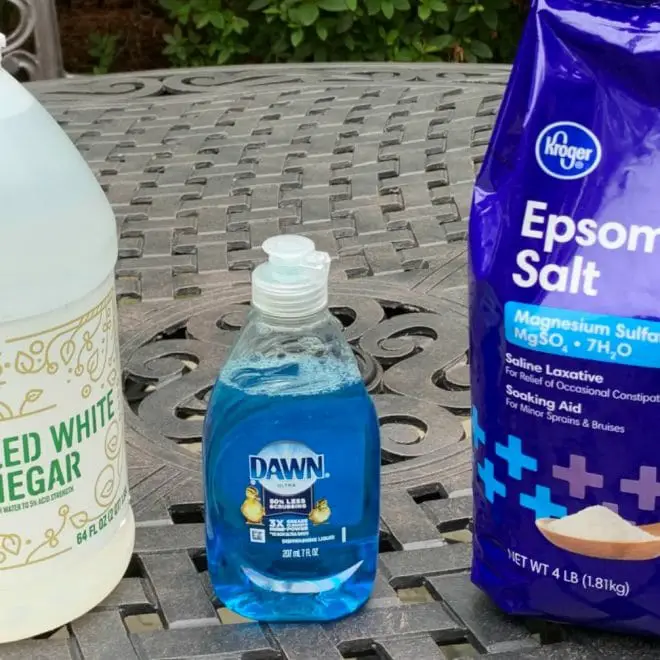Natural Weed Killer Recipe
Are weeds taking over your garden, but you’re hesitant to use harsh chemicals? Look no further! This natural, toxin-free weed killer is not only effective but also easy to make with just three simple ingredients.
Ingredients:
- 1 gallon white vinegar
- 1/4 cup dish soap
- 2 cups Epsom salt or regular salt
Instructions:
- Prepare the Solution:
- Pour the salt into your container.
- Add the vinegar to the container.
- Dissolve Salt:
- Shake the salt and vinegar together thoroughly. For best results, let it sit for about an hour to ensure the salt completely dissolves.
- Add Dish Soap:
- Once the salt is dissolved, add the dish soap to the mixture.
- Combine Ingredients:
- Shake the container again until all the ingredients are well combined.
- Transfer to Spray Bottle:
- Pour the weed killer solution into a spray bottle for easy application.
Notes:
- Effectiveness: It may take up to 24 hours to see the weeds completely die off. Larger weeds may require multiple treatments for complete eradication.
- Suitable Areas: This weed killer spray is best suited for gravel areas, walkways, and other non-plant areas. Avoid using it in flower beds, herb and vegetable gardens, or other areas with plants you want to protect, as the spray will kill both weeds and desirable plants.
- Weather Considerations: For optimal results, apply the spray on a sunny day. The sun will help to dry out the weeds, enhancing the effectiveness of the treatment. Avoid using the spray on damp or rainy days, as this may reduce its efficacy.
With this natural weed killer recipe, you can effectively combat unwanted weeds in your garden without resorting to harsh chemicals. Enjoy a healthier and safer approach to weed control while maintaining a beautiful outdoor space!
Tips:
- Apply on a Sunny Day: Choose a sunny day to apply the weed killer, as the sunlight will help to dry out the weeds and enhance the effectiveness of the solution.
- Prevent Overspray: To avoid accidentally spraying desirable plants, use a shield or piece of cardboard to protect them while applying the weed killer.
- Target the Roots: When spraying the weed killer, aim to cover the entire surface of the weed, including the leaves and stems, to ensure that the solution reaches the roots for more effective eradication.
- Repeat as Needed: For larger or stubborn weeds, multiple treatments may be necessary. Monitor the area and reapply the weed killer as needed until the weeds are completely eliminated.
- Safety Precautions: Wear gloves and protective eyewear when handling and applying the weed killer solution to protect your skin and eyes from irritation.
FAQs (Frequently Asked Questions):
- Is this weed killer safe for use around pets and children?
- While the ingredients in this natural weed killer are generally safe, it’s best to keep pets and children away from treated areas until the solution has dried to avoid any potential irritation.
- Can I use this weed killer on my lawn?
- This weed killer is best suited for use on non-lawn areas such as gravel driveways, walkways, and patios. Avoid using it on lawns, as it may harm the grass along with the weeds.
- How long does it take for the weeds to die after applying the solution?
- It may take up to 24 hours to see visible results, with smaller weeds wilting and dying off more quickly than larger ones. Be patient and monitor the area for progress.
- Can I store any leftover weed killer solution for future use?
- Yes, you can store any unused weed killer solution in a sealed container for future use. Keep it in a cool, dry place away from direct sunlight.
- Will this weed killer harm beneficial insects or soil health?
- While this natural weed killer is less harmful to beneficial insects and soil health compared to chemical alternatives, it may still affect non-target plants and organisms. Use it sparingly and with caution in areas where you want to preserve biodiversity.
- Can I use this weed killer on all types of weeds?
- This weed killer is effective against many common types of weeds, but some may be more resistant than others. Experiment with the solution and adjust your approach as needed based on the results.

